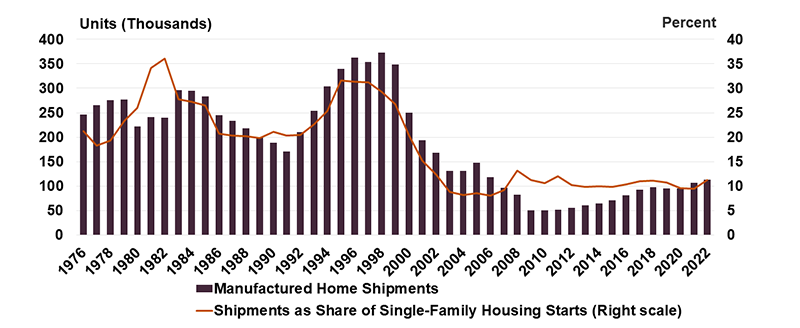Five Barriers to Greater Use of Manufactured Housing for Entry-Level Homeownership
The sharp rise in home prices and interest rates over the last few years has pushed homeownership out of reach for millions of renters, as documented in our State of the Nation’s Housing 2023 report. Under these conditions, it is more important than ever that affordable homes are available for entry-level homeownership. Manufactured housing offers just that, thanks to lower production costs; indeed, the construction cost of a basic single-section manufactured home is roughly 35 percent that of a comparable site-built home. While the savings for larger homes is smaller, it is still significant, with a double-section home costing 60 percent, and a CrossModTM home (which most closely resembles site-built housing) costing 73 percent of comparable site-built homes.
Despite these savings, manufactured housing production remains depressed. During the 1980s and 1990s, more than 250,000 homes were produced on average each year, amounting to 25 percent of the volume of single-family construction (Figure 1). In recent years manufactured home production has just topped 100,000 units annually, about 10 percent of the volume of new single-family homes.
Figure 1: Manufactured Home Shipments Since 1976
Source: JCHS tabulations of US Census Bureau, Manufactured Home Survey and Survey of Construction.
Given the cost advantages and unmet need for more entry-level housing, why has production of these homes remained so low? In our new paper, “A Review of Barriers to Greater Use of Manufactured Housing for Entry-Level Homeownership,” my co-authors and I synthesize what is known about the limiting factors to help identify steps that could increase the production of this important form of housing.
Specifically, in our review, we discuss five key barriers:
- Negative Perceptions of Manufactured Home Quality: Older manufactured homes, particularly those built before the US Department of Housing and Urban Development (HUD) established national standards for these homes in 1974, were of poor quality and limited aesthetic appeal and serve as the basis of popular conception of manufactured housing. However, newer manufactured homes are of much higher quality, with multi-section homes often indistinguishable from site-built housing. Further, studies have found that when the home and the land on which it is sited are jointly owned, these homes appreciate at rates very close to site-built housing. Yet, negative perceptions remain firmly entrenched, limiting both consumer interest and the willingness of localities to allow these homes in their communities.
- Restrictive Zoning and Land Use Regulation: Manufactured homes are often prohibited in zones set aside for single-family housing absent a special permit. State laws preventing the outright exclusion of manufactured housing can help, but these laws typically do not address the design restrictions that are also important barriers, including roof pitch, cladding, foundation heights, lot sizes, and setback requirements. Indeed, one of the most comprehensive studies of regulatory barriers to manufactured housing found a statistically significant association with stricter regulation and a lower likelihood of any homes being sited in a community.
- Market Conditions: However, the same study that found a strong association with strict regulation and lower levels of manufactured homes also concluded that market conditions—including lower land costs, lower density development, and lower household incomes—were equally important in explaining where these homes were more prevalent. This finding highlights that manufactured homes will be most readily adopted in areas where market conditions are favorable.
- A Unique and Limited Supply Chain: The same HUD study also noted how the unique supply chain for manufactured homes, in which homebuyers purchase a home from a retailer but are required to find land on their own, complicates matters. Developers seeking to enter this business must learn a new set of specialized skills related to getting local approvals, siting homes, and financing the unusual development process. The location of factories can also be an issue: the number of factories has declined from more than 300 to about 140 today and factories need to be located within 500 miles of the home site to manage transportation costs.
- Access to Mortgage Financing: A final constraint is the difficulty homebuyers face in accessing mortgage financing. Manufactured homes are generally considered personal property unless owners take steps to change the legal designation to real property, which is necessary in order to be eligible for mortgage financing. The titling process differs by state but can also be complex and time consuming, requiring that the home be permanently affixed to a foundation. If the home is personal property it must use ‘chattel’ loans that bear higher interest rates and have shorter loan terms which can erode the home’s cost advantages. Mortgage applications are also much more likely to be denied for manufactured homes even when titled as real estate, potentially forcing homebuyers to use more expensive personal loans.
While these barriers represent a formidable obstacle to greater use of manufactured homes, they should nonetheless be addressed, and with greater urgency as these homes have the potential to significantly expand homeownership opportunities in markets across the country. Specifically, places where land prices are low yet there are few manufactured homes may offer the greatest potential for expanding this market. Our analysis finds that there are 3.2 million renters earning between 50 and 100 percent of area median incomes in counties across the country who would have difficulty affording a site-built home but who could benefit from the lower cost of a manufactured home. There are also millions of renters in areas where these homes are already prevalent, where there is potential for further growth, and there are high-cost areas where there may be opportunities for making lower cost land available to support this form of development.
Given the cost advantages and affordable homeownership opportunities offered by manufactured housing, there is a strong case to be made that public and nonprofit sectors could help overcome some of these barriers. In a forthcoming paper, we will profile a few examples of efforts that may offer lessons for others to follow.


